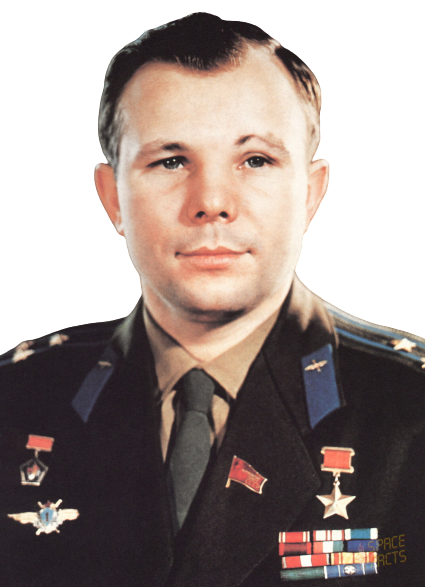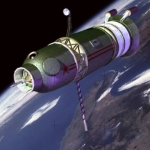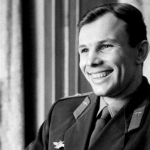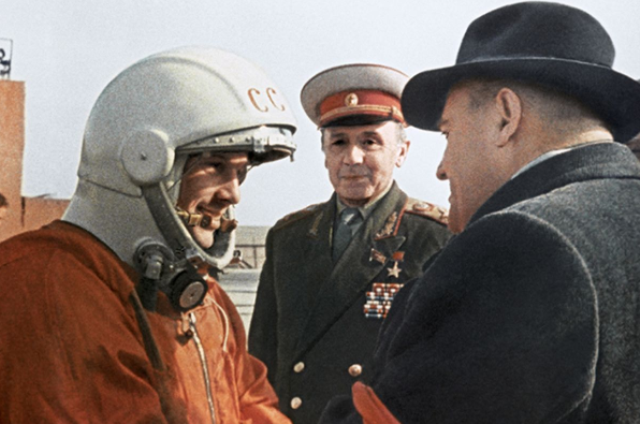
12.01.2023
Sergei Pavlovich Korolev hoped that the propaganda hype surrounding the new record-breaking launches would help to reanimate his authority in the highest military and political circles, and he would be allowed to finally take on the program of sending spaceships to the Moon. Despite expectations, however, the situation remained uncertain.
The Supreme Council of National Economy allocated money for the creation of five more Voskhods for “a complex of medical, biological, physical and technical, and military applications research”: for example, it was planned a long flight of 15 days, a flight with multiple exits to outer space, a flight with artificial gravity by rotation of the ship. But all this rather slowed down the cosmonautics, because “Voskhody” remained the same satellite ships as “Vostok”. The chief designer outsmarted himself: he achieved interest in his specific projects, but now they were pulling back scarce resources. Lieutenant General Kamanin wrote in his diary that he first saw Korolev in confusion and disorientation.
Veterans of the CPC Air Force, including Yuri Gagarin, also expressed dissatisfaction: the delay in designing multi-seat maneuvering spacecraft limited their ability to participate in flights – they were left to engage in administrative and socio-political work, which became tiring for many.
On October 22, 1965, at the suggestion of Nikolai Kamanin, they sent a note marked “top secret” to Leonid Brezhnev, who had replaced Nikita Khrushchev as head of state a year before. I allow myself to quote it almost in full (from the collection “The Soviet Space Initiative in State Documents. 1946-1964, 2008), because the text describes in detail the situation in the Soviet rocket and space industry by the fall of 1965, when American competitors were already in full swing making Gemini orbiters and Apollo lunar vehicles, openly challenging Soviet leadership.

“Dear Leonid Ilyich!
We are addressing you on matters we consider very important to our state and to us.
Everyone is well aware of the successes of the Soviet Union in space exploration; there is no need to list our victories. They exist, they will remain in history, and they will always be the pride of our people. The people, the Party and our leaders have always rightly linked successes in space with successes in building socialism. “Socialism is the best launching pad for flights into space”. This winged phrase flew around the world. The Soviet people proudly uttered these words, the people of socialist countries believed in them, and hundreds of millions of people abroad learned the ABCs of communism by our space successes. So it was.
We cosmonauts traveled abroad many times, we witnessed thousands of times how ardently the masses of millions of people in various countries greeted the Soviet people’s successes in space.
But in the last year the situation has changed. The U.S. has not only caught up with us, but in some areas has come forward. The flights of the Ranger 7, Ranger 8, Mariner 4, Geminay 5 and some other spacecraft are a serious achievement of American scientists.
This lag of our homeland in space exploration is particularly unpleasant for us cosmonauts, but it also causes great damage to the prestige of the Soviet Union and will adversely affect the defense efforts of the countries of the socialist camp.
Why is the Soviet Union losing its leading position in space research? The most common answer to this question is this: the U.S. has deployed a very broad front of research in space, and it devotes enormous resources to space research. (They have spent over $30 billion in five years and $7 billion in 1965 alone.) This answer is mostly correct. It is well known that the U.S. spends much more on space than the USSR. But it is not just a matter of funds. The Soviet Union also allocates a lot of money for space exploration. But, unfortunately, we have many shortcomings in planning, organizing, and directing this work. How can we talk about serious planning of space research when we do not have any plan for flights of astronauts. Not a lot of time is left till the end of 1965, not a person in the Soviet Union knows whether there will be another manned spaceflight this year, what the mission objectives will be, what the duration of the flight is. The same situation was in all previous flights of the Vostok and Voskhod satellites, which creates a completely abnormal situation during the period when the cosmonauts are preparing for the flight and does not allow the crews to prepare in advance for the flight in a calm environment.
We know that there are plans to build space vehicles in this country, we know about the decisions of Communist Party of the Soviet Union and government with specific deadlines of manufacturing spacecraft. But we also know that many of these decisions are not implemented at all, and most of them are implemented with a great delay. Human spaceflight is becoming more and more complex and time-consuming. The preparation of such flights requires a lot of time, special equipment, training ships and simulators, which are now being created with a great delay in a homemade way. In short, we need a state plan for human space flights, which would plan the mission task, date, crew composition, duration of the flight, period of readiness of the spacecraft, simulator and other most important aspects of flight preparation.
Until now, manned spacecraft flights have been conducted according to the plans of the USSR Academy of Sciences, and direct control and technical support was organized by representatives of industry and the USSR Ministry of Defense. Military issues were included in the flight program rather relatively, which can be explained by the fact that within the Ministry of Defense there is no organization that would deal comprehensively with space exploration. Everyone is involved in space: the Rocket Forces, the Air Force, the Air Defense Forces, the Navy and other organizations. Such fragmentation of efforts and funds for space exploration hampers the cause, much time is spent on coordinating plans and decisions, and decisions are often affected by a departmental approach to the cause. The current situation with the organization of space research contradicts the spirit of the decisions of the September plenum of the CPSU Central Committee and must be changed. ‘…’
The Air Force Command and we cosmonauts have repeatedly appealed to the General Staff, to the Minister of Defense and to the Military-Industrial Commission with specific proposals for the construction and equipment of spacecraft capable of solving problems of combat use. Our proposals, as a rule, were not supported by the leadership of the Rocket Forces. We used to receive resolutions: “Vostoks have no military value and it is not expedient to order them”, “We will not order Voskhody, no means”.
In 1961 we had two Vostoks.
In 1962 we had two Vostoks.
In 1963 we had two Vostoks.
In 1964 we had one Voskhod.
In 1965 we had one Voskhod.
(The Americans launched two Geminay spacecraft in 1965 and expect to launch two more before the end of the year.)
Why didn’t they build spaceships for astronaut flights? At any rate, it is not because of a lack of funds. It is because the leaders of the Rocket Forces put more faith in automatic satellites and underestimate the role of humans in space exploration. It is embarrassing to admit, but it is a fact that in our country, which was the first to send a man into space, discussions have been going on for four years on the question: “Is a man needed on board a military spacecraft?”
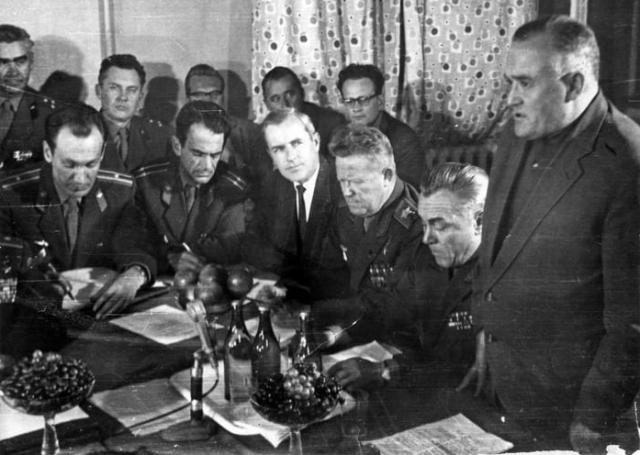
In America this question is firmly and finally resolved in favor of man, and in our country even
today many people are in favor of automatic weapons. Only this can explain the fact that we
build 1-2 manned spacecraft for 50-40 satellites-automatics. Many automatic satellites cost a
lot more than a manned ship, and many of them do not reach their targets.
“Vostoks and Voskhods with a man on board fully implemented the program of scientific research and at the same time brought a great political effect for the country. We are not going to belittle the importance of automatic spacecraft. But, to say the least, their infatuation is harmful. The Vostoks and Voskhods could carry out a large complex of very necessary military research, and extend their flight time to 10-20 days. But we do not have ships, nothing to fly on, nothing to carry out space research program.
In addition to the above, there are other drawbacks in the organization of our flights, which we cannot fix by our own efforts. Our country has no unified staff control station for space flights. During the mission the spacecraft has no communication with the command post during the period from the 6th to the 13th rotation of each 24-hour period.
There are no conditions at the test site to keep the cosmonauts trained and well rested. We still have other questions, which are waiting to be solved. Many questions could have been solved without reference to the CPSU Central Committee. We repeatedly appealed to the Minister of Defense on these issues. We are aware of the Air Force Command’s appeals to the Ministry of Defense and the government, but these appeals mostly failed to reach their goals.
We had many meetings with the Minister of Defense, but, unfortunately, these were not business meetings. And today we have no confidence that the issues we raise can be resolved in the Ministry of Defense.
My dear Leonid Ilich, we know you are very busy, but nevertheless, we ask you to become acquainted with our space affairs and needs.
The 50th anniversary of the Great October Revolution is approaching. For this great holiday, we would very much like to achieve new great victories in space.
We are deeply convinced that the solution of the problem of unification of military space on the basis of the Air Force, thoughtful planning of space research and creation of spacecraft to solve problems of manned space flight applications will greatly strengthen the defense power of our Motherland”.
Pilot-cosmonaut of the USSR
As you can see, since 1963, despite all the initiatives of cosmonauts, aviation high command and the creators of rocket and space technology, the situation with the development of Soviet manned cosmonautics has not moved from the dead point. Chasing records, the Soviet Union lost the strategic initiative in extraterrestrial space exploration, yielding to the United States. There was only one way out: to create a new-generation spaceship, the Soyuz. After almost all the space initiatives of Sergei Pavlovich Korolev were rejected in 1961, events developed as follows. Initially, the designers of OKB-1, who worked on the “North” theme, did not assume that they would boost the R-7 rocket and proceeded from its carrying capacity of 5 tons. A spacecraft to orbit the Moon did not fit in Vostok’s dimensions, so they decided to assemble it from separate units in orbit around the Earth and only then launch it to the Moon.

On March 10, 1962, chief designer Korolev approved a technical proposal, entitled “Assembly of a spacecraft in orbit as a satellite of the Earth (Theme “Soyuz”)”. It substantiated the use of a manned spacecraft, code-named Vostok-7, for practicing the lunar complex assembly procedure in orbit, for which the ship was proposed to be equipped with rendezvous and docking systems, as well as a multiple-start march propulsion system.
A year later, on May 10, 1963, the second prospectus was published, in which the Soyuz theme became more specific. Now the complex included a manned two-man spacecraft, which inherited the designation “7K” from the Severn, a rocket unit for acceleration to the second space speed “9K” and tanker ships “PK”. All spacecraft were to be launched into near-Earth orbit by a carrier based on R-7. Block “9K” was launched first, then four tankers “PK” were docked to it in turn, in automatic mode, to fill it up with long term storage fuel. The last to start was the “7K” ship with the crew. After its docking with the upper stage, the bundle was sent to orbit the Moon.
However, with less financing, all efforts of the OKB-1 were thrown into conversion of the Vostok into a three-passenger Voskhod. In August 1964, development of a spacecraft to round the Moon was assigned to competitors from the bureau of Vladimir Nikolayevich Chelomey, who proposed a project of a one-pass rocket plane LK-1, launched with their own powerful rocket, the UR-500K (Proton). Development of lunar complex “7K-9K-11K” was discontinued. Sergei Korolev again had to make efforts to preserve the groundwork. He obtained permission to use the 7K to practice the system of docking in low Earth orbit, which in any case would be necessary for construction of long-lived military stations: in August 1965, the lunar lander was turned into the orbital 7K-OK, which inherited the sonorous name Soyuz from the previous project.
The main problem of the new stage was political intrigue. Sergei Korolev joined forces with Nikolai Kamanin to bring cosmonautics under the wing of the Air Force. The cosmonauts, who remained fighter pilots, supported this choice in every possible way. But the rocket and air defense forces wanted to keep the industry for themselves.
The cosmonauts’ appeal to Leonid Brezhnev finally gave the matter a boost. There were several significant meetings at the top about the future of cosmonautics. However, perhaps the strongest argument in the debate was the successful group flight of the U.S. Gemini 6 and Gemini 7 in December 1965. As the cosmonauts predicted in their letter to Brezhnev, the solitary flight of the Voskhod 2 was completely lost against the background of the American spacecraft, which maneuvered and performed complex operations in orbit. The leading comrades immediately began exchanging angry letters demanding to regain lost superiority and finally gave the “green light” to the Soyuz project.
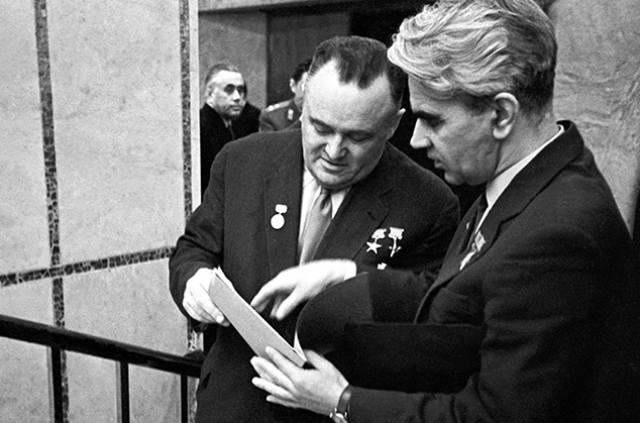
The year 1965 was ending on the rise of the hopes of the rocket and space industry personnel. The work on the superheavy rocket N-1, projects of spacecraft to orbit the Moon and land on its surface was resumed. The 7K-OK (Soyuz) orbital spacecraft received serious support. The veterans of the cosmonaut squad could seriously expect to be called to test the new equipment. They dreamed of going to the Moon and then to Mars. They almost succeeded.
On January 1, 1966, Pravda newspaper published another article by Professor K. Sergeyev (recall that this was the pseudonym under which Sergey Korolev was published), “Steps into the Future”: “In the future, for a more complete and systematic accumulation of the necessary information about the Moon and at least about the near-Earth planets, there is no doubt that serious and lengthy research will be required. In the near future, one-time flights of automatic
stations will no longer be able to satisfy the demands of science to any sufficient extent. The period of the first sensational discoveries and the first photographs taken from long distances and not of a systematic nature will clearly be insufficient. Needless to say, how long ago, how strongly and irresistibly the Moon attracted human attention. Humanity’s dream has been to have a son of the Earth finally set foot on the pristine surface of the Moon! Unfortunately, this task is not so simple and not so close to realization. ‘…’ Each space year is a new step forward for domestic science on the path of knowledge of the innermost mysteries of nature. Our great compatriot K. E. Tsiolkovsky said:
“The impossible today, becomes possible tomorrow. The entire history of the development of astronautics confirms the rightness of these words. What seemed unattainable over the centuries, what yesterday was only an audacious dream, today is becoming a real challenge, and tomorrow – the fulfillment. There are no barriers to human thought!”
Two weeks later, on January 14, 1966, Sergey Pavlovich Korolev died on the surgeon’s table during a routine surgery.
His death shocked not only the people close to him, but also the whole world. The name of the mysterious chief designer, which had been classified for many years, suddenly became widely known: in addition to extensive obituaries, they began to publish his articles, study his legacy, publish his biography. The impression – largely false! – that he was almost the only person who created Soviet cosmonautics. And, of course, one of the reasons for any subsequent failures was his untimely death.
The cosmonauts, and especially Yuri Gagarin, for whom Sergei Pavlovich was a superauthoritative and a man who discovered a new image of the future, took Korolev’s departure very seriously. And this image was so visible, seemed so close that Yuri Gagarin and Alexei Leonov decided on a bold act: before the ceremony of burying the ashes of the chief designer in the Kremlin wall they broke into the crematorium and stole some slivers, so that later, when one of them will get to the moon, to arrange a symbolic funeral. The ashes were stuffed into a small capsule. Gagarin used to hide it in his work safe, but then it got “lost”. Of course, the projects launched by Sergei Pavlovich Korolev during his lifetime were developed.
But not all of them were brought to their logical conclusion.
